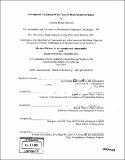Development of a robust work transfer iomplementation process
Author(s)
Murdoch, Kimberly R
DownloadFull printable version (6.749Mb)
Other Contributors
Leaders for Manufacturing Program.
Advisor
Paul A. Lagace and Roy E. Welsch.
Terms of use
Metadata
Show full item recordAbstract
The industry-wide need for a robust method of transferring the manufacturing of a component from one location to another is addressed in this thesis. Work transfer activities can be initiated due to a number of business reasons. These reasons include: reducing general operating costs, increasing asset utilization, and reducing overhead costs by leveraging manufacturing synergies. However, in order to fully realize the benefits of a work transfer activity, a robust work transfer process is needed to mitigate the risks associated with work transfer activities. In this thesis, the work transfer process is studied with specific concentration on the implementation phase of the work transfer. The overall objective is to propose and document a robust work transfer implementation process that improves the reliability with which work transfers are executed. The current work transfer process at The Boeing Company, in addition to the strategic and business decisions that initiate work transfers and the selection of manufacturing processes and technologies, serve as the starting point of the work and associated considerations. In developing this recommended work transfer process, robustness was addressed as the risks associated with the implementation of work transfer activities and subsequent risk mitigation activities were identified, in cooperation with key stakeholders, via a failure modes and effects analysis (FMEA). These risk mitigation activities were then integrated into the current work transfer process, and the resulting overall process was documented. This recommended process was then assessed by comparing it with the current work transfer process on the basis of time and cost. The results of this assessment indicate that the recommended work transfer is an improvement over the current work transfer process. The recommended process is presented generically, and as such is flexible due to its adaptability to individual situations. When implementing the recommended work transfer process, it is suggested that the responsibility for and authority of the work transfer process be assigned to an individual to ensure adherence to and adoption of the process. System-level interactions of factors within a manufacturing system are also investigated and presented in this thesis. The results of this investigation illustrate the need to consider the potential long-term system-level results when making business decisions. Finally, the issue of manufacturing flexibility is discussed, and the consideration of manufacturing mobility during the design of manufacturing processes is suggested.
Description
Thesis (M.B.A.)--Massachusetts Institute of Technology, Sloan School of Management; and, (S.M.)--Massachusetts Institute of Technology, Dept. of Aeronautics and Astronautics; in conjunction with the Leaders for Manufacturing Program at MIT, 2004. Includes bibliographical references (p. 121-122).
Date issued
2004Department
Leaders for Manufacturing Program at MIT; Massachusetts Institute of Technology. Department of Aeronautics and Astronautics; Sloan School of ManagementPublisher
Massachusetts Institute of Technology
Keywords
Sloan School of Management., Aeronautics and Astronautics., Leaders for Manufacturing Program.